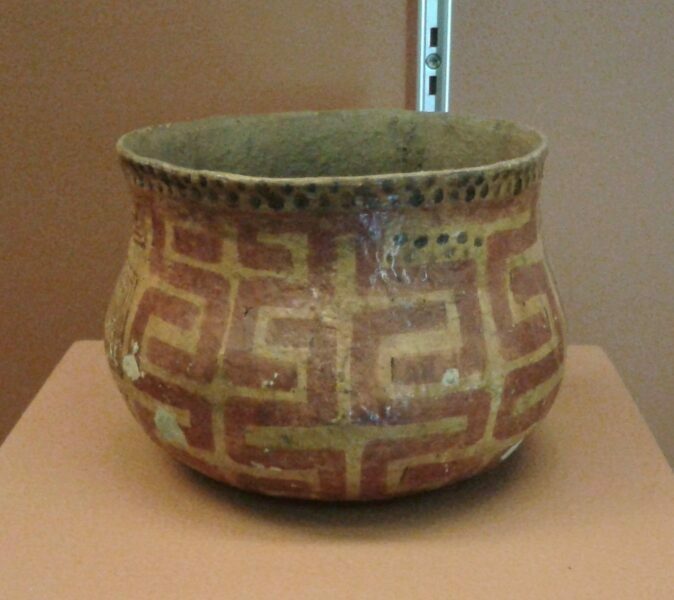The Asurini indigenous people of the Xingu, who call themselves Awaeté, inhabit the middle region of the Xingu River – a Brazilian Amazonian river and one of the main tributaries of the Amazon River’s southern slope – which flows through the states of Mato Grosso and Pará. Officially contacted in the 1970s, they stand out for their material culture, which includes the elaboration of ceramics, textiles, basketry, weapons, body ornaments, wooden benches, flutes, among others, but they are especially known for being virtuosos of Amazonian indigenous art through the application of various geometric designs both in facial and body ornamentation as well as in ceramics and other objects.

Territory and population Asurini del Xingu
Currently, the Asurini village is located on the right bank of the Xingu River, where the Koatinemo Indigenous Land is located, near Altamira in the state of Pará, homologated in 1986. It currently has an estimated population of 130 people (Polo, 2019) (3).
Language
The language of the Asurini belongs to the Tupi-Guarani linguistic family.
Housing
In the Asurini community there are different types of houses, the most common of which are mud-walled, with a wooden structure and thatched roofs, where families live. The largest house in the village(aketé, tavywa), with a rectangular floor plan, is approximately 30 meters long, 12 meters wide and 7 meters high, corresponding to the description of a typical Tupi dwelling. Traditionally, the aketé or tavywa was the collective residence of the local group. More recently, reunited at the post of the National Indian Foundation of Brazil, the Asurini reorganized themselves into a group made up of individuals from different local groups due to the population decrease of this indigenous people. However, the imminent danger of extinction of this ethnic group contrasts with the vitality of its culture in its various manifestations, especially its elaborate graphic art system (Instituto Socioanbiental, ISA, n.d.) (1).
Amazonian art Asurini in body painting and ceramics
An outstanding characteristic of the Asurini is their artistic and aesthetic sensitivity in their material production, based on traditional knowledge and cultural reproduction, which allows the reaffirmation of their cosmovision as well as their cultural identity in general.
In this sense, the Asurini stand out for being the protagonists of a graphic art with geometric designs applied to the body and ceramics, and other objects for both everyday and ceremonial use. In this way, these indigenous people make a variety of vessels, with yellowish walls covered with one or more graphics with a layer of jatobá resin, which gives them a shiny finish. Likewise, in the various rituals of the Asurini culture, body painting is complemented with other ornamental elements such as feathers, necklaces and others. This graphic art is of special importance in the production and transmission of the ancestral cultural heritage of this Brazilian Amazonian indigenous culture (Governo Federal, Ministério da Cultura, 2022) (2).
Within the Asurini culture, the decoration of the human body admits any drawing motif applied on ceramics, the most varied field of shapes and decorative patterns used. However, the Juaketé pattern is the only one used exclusively in the female body painting of this indigenous group, which translates as “real painting”, where the drawing is subordinated to the shape of the body. In the pattern JuaketéThe circle from which the lines and rhombuses that cover the trunk and thighs start is applied on the articulation of the legs and trunk; it follows the pattern tamkyjuak (rhombus) which translates as “leg painting”, proper to that part of the body (Polo, 2019) (3).
According to Polo (2019) (3), the body ornamentation of the Asurini. with a geometric drawing expresses a content related to the social category; but in addition not only the body is painted but also the different objects of the material culture; in such a way in them the drawing is abstract, decorative and symbolic, expressing therefore basic notions of thought proper of this indigenous community, which refer to the representation of supernatural beings, nature, and culture. Thus, in the graphic art of the Asurini, the geometrization of space mixes cosmic domains, through visual abstractions with symbolic content; relating the vital principle, shared by human and spiritual beings, directed by the shaman.
Marriage
The Asurini indigenous women marry in adolescence but have their first child in their youth, at approximately twenty-five years of age, since they are previously learning and perfecting their household and subsistence work (ISA, n.d.) (1). The Asurini are governed by the rule of uxorilocal or matrilocal residence, which from the point of view of social anthropology, refers to a system of postmarital cohabitation in which the married couple resides near the matrilineal part of the family, that is, with the wife’s mother and her matrilineal ancestors.
Procreation Asurini two husbands, one young, one old
According to ISA (n.d.) (1), a condition for procreation in the indigenous Asurini ethnic group is the existence of two husbands, one young and the other older. During gestation and up to the fourth month, several men have frequent sexual relations with the woman so that the child is “born strong”, but then only the two parents married to the mother participate in the child’s upbringing. One of the reasons given by Asurini women for not procreating is the absence of a young father.
Subsistence economic activities
Traditionally, agriculture has been the main subsistence economic activity of the Asurini people, along with hunting, fishing and gathering. Cassava is the staple food in the diet of these indigenous people, who consume it in different ways, with flour being one of the main products; they also grow corn, cará(Dioscorea alata), sweet potato, tobacco, cotton, urucum, peanuts, beans, watermelon, banana, among others (ISA, n.d.) (1).
References
- Socio-environmental Institute of Brazil, ISA. n.d. Povos indígenas no Brasil. Asurini do Xingu. Retrieved from https://pib.socioambiental.org/es/Povo:Asurini_do_Xingu#Historia_del_contacto.
- Governo Federal, Ministério da Cultura. 2022. Asurini do Xingu. Retrieved from http://colecaobei.com.br/sobre/asurini-do-xingu/19.
- Polo Müller, R. 2019. Amazonian art today and its influence on contemporary Brazilian art. In Bolaños, A (comp.). Amazon millenary route IV. Amazonian: body, person and place. Lima: Petróleos del Perú. Retrieved from https://nanopdf.com/download/el-arte-amazonico-en-la-actualidad-y-su-influencia-en-el-arte_pdf.

Economist (Central University of Venezuela). Full professor and researcher attached to the “Edgar Abreu Olivo” Agrifood Research Center, Universidad de Los Andes. Doctor from the University of La Laguna (Spain). Award “One of the 10 most consulted authors of the Saber ULA university portal” (2005); prize in the III Essay Contest of the Central Bank of Venezuela BCvoz Economico, 2016, with the work “Theobroma cacao: transformation and consumption of the “food of the gods” in Venezuela and the world” (co-authored).
This post is also available in:
![]() Español (Spanish)
Español (Spanish)
